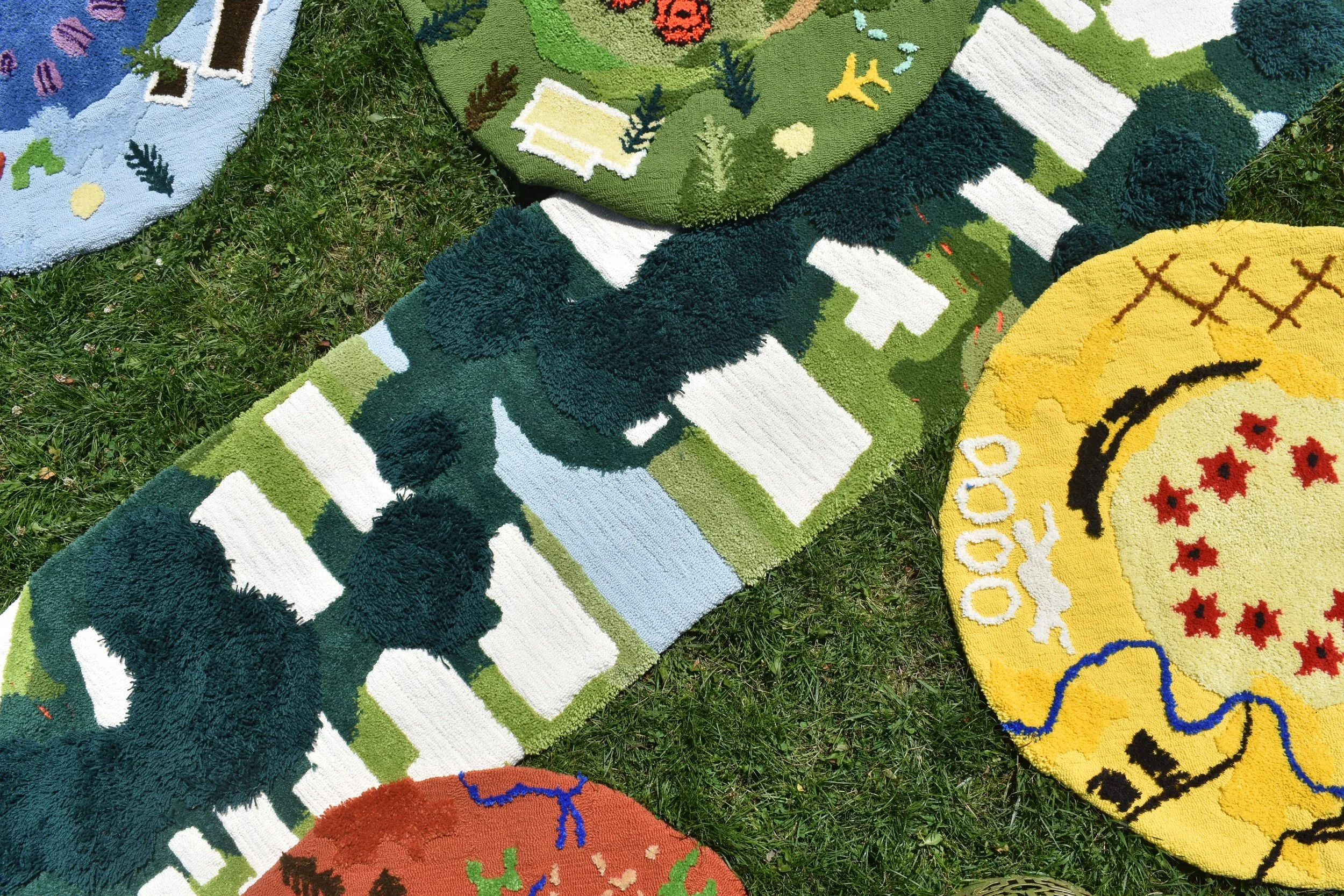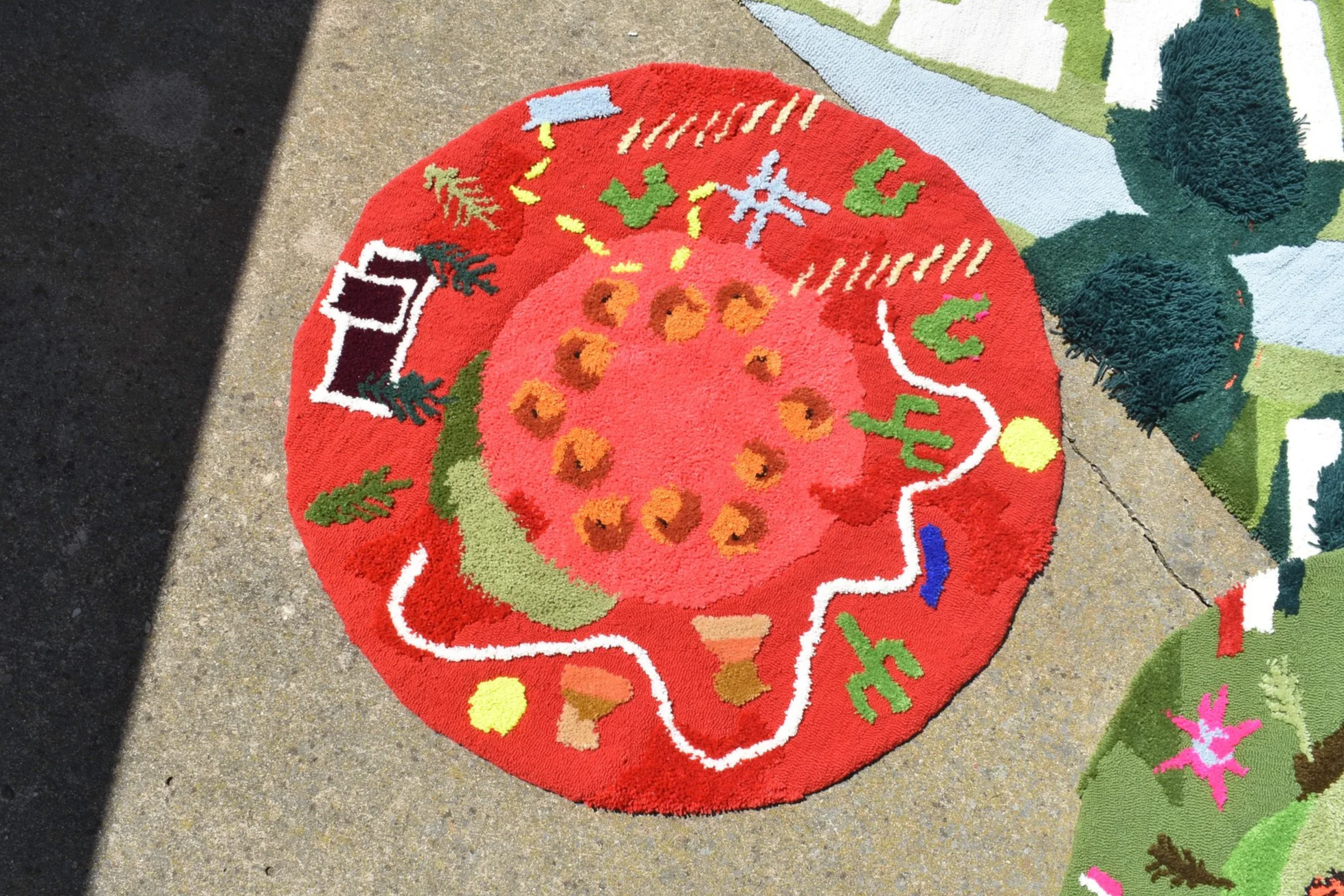Making Homelands: Tufting San Lazaro Lifeways / Construyendo el Lugar de Origen: Tejiendo los Modos de Vida de San Lazaro
Boulder, Colorado / Fall 2024-Fall 2025 / Exhibition / Community Power, Immigration, Environmental Justice, Textile Design
This exhibit is a series of tufted textiles that storymap San Lazaro families. The textiles record the ecologies present and changing over time and space, witnessing where folks make home. The series is a visual interview, each rug telling a story with a different family, alongside a transect of life in San Lazaro Mobile Home Park in Northeast Boulder. Visitors are encouraged to engage with the work visually and haptically, seeing and touching the journeys of some of the people who live at San Lazaro.
This research combines quantitative information in the form of spatial mapping and qualitative information from the oral histories of the residents. Each family was given a series of prompts to answer intergenerationally, about memories of home, how they got here, and emotions and senses along the way. The textile series tells the stories of San Lazaro through many lenses: ecological, familial, cultural, physical, and temporal.
Esta muestra presenta una colección de tejidos que cuentan las historias de vida de las familias de San Lazaro. Los tejidos registran las ecologías presentes y cambiantes a lo largo del tiempo y el espacio, dando testimonio de los lugares donde las personas hacen hogar. La serie es una entrevista visual, cada alfombra cuenta una historia con una familia distinta, a lo largo de un recorrido de vida en San Lazaro, un parque de casas móviles en Northeast Boulder. Se anima a los visitantes a interactuar con la obra visual y hápticamente, viendo y tocando San Lazaro.
Este estudio combina información cuantitativa en forma de mapeo espacial y cualitativa en forma de historias orales de los residentes. A cada familia se le dio una serie de indicaciones para responder de manera intergeneracional sobre los recuerdos del hogar, como llegaron hasta aquí y las emociones y sentidos a lo largo del camino. La serie de tejidos cuenta las historias de San Lazaro a través de varios lentes: ecológico, familiar, cultural, físico y temporal.
Journey of Manuela Longoria
Exhibition is at the Sustainability, Energy and Environment Complex Gallery on CU Boulder East Campus from November 3 - December 5th.
One side of the exhibition is a transect of San Lazaro, which maps the micro-climate of the community, and imagines neighbors' journeys from home to home visiting friends. Colors show the range of temperatures from high heat off the asphalt roads to cooler temperatures under the tree canopy.
The adjacent wall features the journeys of eight families that live in San Lazaro, one per rug. The outside circle includes anecdotes, flora and fauna, and modes of transportation from one place to another. These illustrations are inspired by mythohistories, exaggerating memory and space, senses, and experiences. In the middle of each journey is a key species from one’s homeland, including traditional roots, plants, and flowers. Each circle shows the current summer and winter, and the generational (60 years into the future) climate projection of precipitation. So if a city is projected to receive less precipitation, the object shrinks, and if it is supposed to get wetter, the object expands. According to the University of Maryland Center for Environmental Science, Appalachian Lab, Boulder is projected to get 9% wetter in the summer and 15% wetter in the winter over the next 60 years.
A un lado de la muestra se extiende un transecto de San Lazaro, que mapea el microclima de la comunidad, e imagina los viajes de los vecinos de una casa a otra visitando a amigos. Los colores muestran el rango de temperaturas desde el calor intenso sobre los caminos de asfalto, hasta las temperaturas más frescas bajo las copas de los árboles.
La pared adyacente presenta los viajes de siete familias que viven en San Lazaro. El círculo externo incluye anécdotas, flora y fauna y modos de transportación de un lugar a otro. Estas ilustraciones están inspiradas en mitohistorias, exagerando la memoria y el espacio, los sentidos y las experiencias. En el centro de cada viaje hay una especie clave del lugar de origen, que incluye raíces tradicionales, plantas y flores. Cada círculo muestra la precipitación actual en verano e invierno, así como la proyección climática generacional (60 años en el futuro). De modo que, si se proyecta que una ciudad recibirá menos precipitación, el objeto se reduce, y si se espera que reciba más lluvia, el objeto se expande. Se proyecta que Boulder tendrá un 9% más de lluvia en el verano y un 15% más de lluvia en el invierno durante los próximos 60 años.
This work was started two years ago, and as the immigration landscape changed, the focus of the work changed as well. After many conversations with participants, it was clear that the most significant part of the project was telling stories within families, to make sure immigrant parents/grandparents and first-gen kids knew their family history and where they came from. As a child of an immigrant myself, it was an honor to hold that space and translate stories of many homes.
This work was completed in the context of federal agencies disappearing people, people who deserve to live with dignity and safety, where they have put down roots. This is a reminder to continue giving and supporting local rapid response networks. Here is Denver’s: https://www.coloradorapidresponsenetwork.com
Making Homelands has been exhibited at the Boulder Public Library, Arapahoe Gallery, from August 5 - October 29, 2025.
This work was produced as a collaboration between the Community Engagement, Design and Research Center (CEDaR) in the Environmental Design Department at CU Boulder, EcoArts Connections, and seven San Lazaro Mobile Home Park families with designer Sophie Weston Chien. It has been supported by Art Omi: Architecture, CU Boulder PACES Grant, CU Boulder Council for Arts + Humanities Grant, National Association of Minority Landscape Architects BIPOC Educator Research Grant, and through EcoArts Connections by the Boulder Arts Commission and the Schramm Foundation. Thanks to Marda Kirn, Susana Roriguez, Rosabelle Rice, Claudia Lopez, Leticia Pérez González and Tuft Love.





